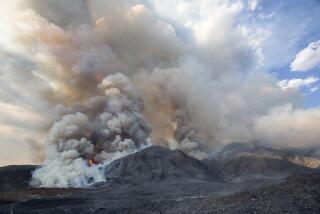Planet-warming methane leaking at higher rate, study finds
- Share via
Federal regulators are missing about 14 million metric tons of greenhouse gas in their annual inventory, most of which likely comes from the nation’s growing natural gas industry, according to a new study.
But despite the higher estimate of methane leakage, switching from coal to the cleaner-burning fuel makes long-term sense for reducing greenhouse gases linked to climate change, according to an analysis of data in 200 studies, published online Thursday in the journal Science.
“While we believe the leakage rates are likely higher than official estimates, they’re unlikely to be high enough to disfavor shifting from coal to natural gas,” said the study’s lead author, Adam R. Brandt, an energy resource engineer at Stanford University.
Not all policies involving natural gas are equally beneficial, the study warned. Although burning natural gas instead of gasoline in motor vehicles might benefit the planet over the next 100 years, switching from diesel buses, an increasingly common policy in many cities, could wind up creating more planet-warming gas, according to the study.
The analysis does not blame all the excess methane in the atmosphere on the natural gas industry -- authors said they could not quantify the sector’s contribution with scientific accuracy. The industry is considered to be a major source of the excess atmospheric methane, with smaller contributions coming from the cattle industry, oil wells, wetlands, natural seeps and other sources.
Within the natural gas industry, Brandt said, “the evidence does not suggest that hydraulic fracturing is the dominant contributor” to leaking methane. The method, which uses injected water and other chemicals to crack rock formations to access gas deposits, has generated controversy over risks to local water supplies and other damage.
About 1.5% of the nation’s gross production of methane leaks into the environment, according to the Environmental Protection Agency. That would be equivalent to about 1.2 billion metric tons of carbon dioxide (measurements of greenhouse gases are converted to “carbon dioxide equivalents” to account for their varying effects on the atmosphere.)
“Methane is a potent greenhouse gas with a global warming potential about 30 times that of CO2, so relatively small leaks can have a significant impact,” Brandt said.
The study is the first to systematically compare published estimates of methane emissions. A team of 16 scientists from nine universities, several government agencies and laboratories, and an environmental advocacy group eventually narrowed their focus to 10 peer-reviewed studies that they considered to be representative and comprehensive. They ranged from those using point measurement of equipment on the ground to broader aerial surveys.
The team also calculated “switching points” where the carbon footprint of producing and burning natural gas would equal or exceed that of using coal. Only if the industry’s leakage amounted to 7.4% of gross production -- an unlikely figure -- its footprint would equal that of coal, Brandt noted. For gasoline, leakage rates would have to be 3.8%, he said.
But a leakage rate of just 1.7% cancels out the benefits of switching from diesel, according to the study. That’s close enough to the current estimated leakage rate to make the switch a wash, Brandt said.
The EPA has been aware of discrepancies pointed out in academic studies.
“EPA is committed to using the best available data for our inventory and continually seeks opportunities to update and improve our estimates,” a written statement from the agency said. “Studies like these will add to our knowledge base of greenhouse gas emissions and will help us refine our estimates going forward.”
A spokesman for America’s Natural Gas Alliance said the industry emits less than the EPA estimates, in part because it has been capturing gas that once was vented or burned at wells during development.
“Our member companies are continually refining and updating their equipment and practices to lower emissions occurring in the production process,” spokesman Robert Sumner said. “We will continue working to ensure our operations reduce environmental impact as we use more natural gas to answer our growing energy demands.”







